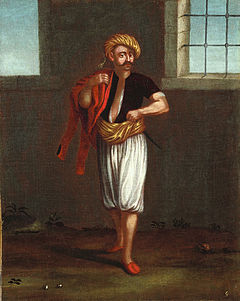Patrona Halil
You can help expand this article with text translated from the corresponding article in Turkish. (August 2010) Click [show] for important translation instructions.
|

Patrona Halil (
Halil was born to an

His followers were 12,000 janissaries, mostly Albanians. For weeks after the revolt, the empire was in the hands of the insurgents. Patrona Halil rode with the new sultan to the Mosque of Eyub where the ceremony of girding Mahmud I with the Sword of Osman was performed; many of the chief officers were deposed and successors to them appointed at the dictation of the bold rebel who had served in the ranks of the Janissaries and who appeared before the sultan bare-legged and in his old uniform of a common soldier. A Greek butcher, named Yanaki, had formerly given credit to Patrona and had lent him money during the three days of the insurrection. Patrona showed his gratitude by compelling the Divan to make Yanaki Hospodar of Moldavia. Yanaki however never took charge of this office.
The
The aftermath of the rebellion led to fears of security and crime, this led to stronger state policies to regulate life in Istanbul.[2]
References
- ^ Altınay, Ahmet Refik (Hrz. Haydar Ali Dirioz), (1973) Lale Devri
- ^ ISBN 978-90-04-27455-6.
Sources
- Başaran, Betül (2014). Selim III, Social Control and Policing in Istanbul at the End of the Eighteenth Century: Between Crisis and Order. BRILL. ISBN 9789004274556.
- Faroqhi, Suraiya; McGowan, Bruce; Pamuk, Sevket (1997). An Economic and Social History of the Ottoman Empire, Volume 2. Cambridge University Press. ISBN 9780521574556.
- Jókai, Mór (2012). Halil the Pedlar A Tale of Old Stambul. tredition. ISBN 9783847209188.
